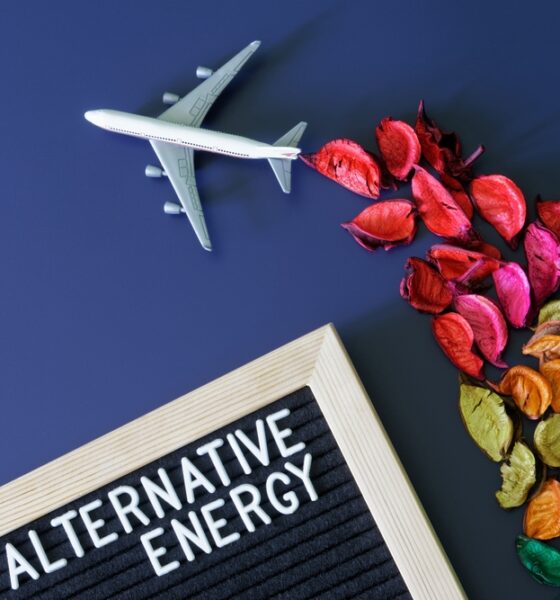

Features
Eco-Friendly Airlines Use Weather Models to Make Safer Flights
The airline industry is taking a number of new steps to promote sustainability. The European Regions Airline Association reports that the industry accounts for 2-3% of global carbon emissions, but the real number may be a lot higher.
We talked about three of the huge ways airlines are promoting sustainability. However, this doesn’t mean that they don’t care about safety as well. One of the biggest things that they are doing to ensure both sustainability and safety is using weather models.
Weather Models Help Eco-Friendly Airlines Make Safer Flights
The aviation industry has come a long way in ensuring passenger safety. One of the most critical factors contributing to safe air travel is accurately predicting weather patterns. The weather can have a significant impact on an aircraft’s performance, and as such, airline operators must have access to reliable weather information.
Weather models are mathematical algorithms that use current and historical weather data to simulate future atmospheric conditions. These models help airlines and pilots make informed decisions about flight routes, timing, altitude, and other critical factors that affect flight safety. A growing number of eco-friendly tourists are using weather models to make flights safer.
In this blog post, we will explore how the best weather models contribute to safer flights by examining their role in predicting adverse weather conditions and improving operational efficiency.
Weather Challenges in Aviation:
In aviation, the skies are only sometimes clear and calm. Pilots, airlines, and air traffic controllers contend with weather challenges that significantly impact flight safety and operations. These challenges underscore the need for accurate and up-to-date weather information to ensure that flights proceed smoothly and passengers arrive at their destinations safely. Let’s delve into some of the prominent weather challenges that aviation faces:
- Turbulence: Unpredictable pockets of air turbulence pose a significant challenge, causing discomfort to passengers and potentially affecting the aircraft’s stability.
- Thunderstorms: Thunderstorms bring lightning, strong winds, and heavy precipitation, making them hazardous to aviation. They can disrupt flight paths, trigger delays, and require careful navigation to avoid severe weather cells.
- Icing Conditions: Sub-freezing temperatures at higher altitudes can lead to ice buildup on aircraft surfaces, affecting aerodynamics and potentially causing loss of control.
- Crosswinds: Strong crosswinds during takeoff and landing can challenge pilots’ skills, impacting safe aircraft handling and potentially leading to runway excursions.
- Low Visibility: Fog, mist, and low clouds reduce visibility, making visual navigation and runway approaches challenging. This often necessitates the use of advanced instrument landing systems (ILS).
These weather challenges demand vigilance, meticulous planning, and real-time updates to ensure that flights remain safe, passengers are comfortable, and aircraft operations are carried out seamlessly despite the atmospheric hurdles.
The Role of Weather Models:
Weather models emerge as the unseen heroes in aviation safety, offering insights that help pilots and aviation professionals navigate the complexities of the atmosphere. These models are a crucial component in ensuring safe and efficient flight operations, which in turn contributes to airline sustainability. Here’s how weather models play a pivotal role:
- Data Integration: Weather models serve as the cornerstone of aviation safety by assimilating data from many sources. These models paint a comprehensive picture of the ever-changing atmospheric landscape by amalgamating inputs from satellites, radar systems, and ground-based sensors. This synthesis empowers pilots and aviation experts with a profound understanding of meteorological conditions, ensuring that flights are charted in alignment with real-time environmental factors.
- Predicting Adverse Weather: An indispensable shield against potential dangers, weather models excel in predicting adverse weather conditions. Through intricate algorithms, these models anticipate turbulence, thunderstorms, and other menacing elements that could jeopardize passengers and crew. Armed with these forecasts, pilots can proactively reroute flights, circumventing hazardous zones and ensuring a smoother, safer journey for all onboard.
- Flight Planning: Weather models are instrumental in flight planning, optimizing routes for fuel efficiency and passenger comfort. Pilots chart paths that minimize exposure to inclement weather by analyzing intricate atmospheric patterns, enhancing the overall travel experience. Through this predictive prowess, weather models enable airlines to streamline operations, reduce flight delays, and improve the reliability of their services.
- Altitude Selection: The strategic selection of cruising altitudes is an art mastered by weather models. These models give pilots insights into optimal altitudes, steering clear of turbulent air layers, and maintaining passenger comfort. By harnessing this information, pilots can ensure a tranquil and secure journey, soaring above potential disruptions while delivering an elevated travel experience.
- Real-time Updates: The real-time capabilities of weather models emerge as a lifeline during flights. These models enable dynamic course adjustments by continuously updating pilots about evolving weather patterns. Pilots remain poised to maneuver around developing weather challenges, guaranteeing a smoother flight trajectory and minimizing potential discomfort for passengers.
- Emergency Preparedness: In the face of unexpected weather anomalies, weather models prove invaluable for crafting emergency response strategies. With the ability to swiftly generate alternative routes, these models ensure that pilots are equipped to redirect flights to safer pathways. This proactive approach bolsters safety, reassuring passengers and facilitating prompt decisions that mitigate potential risks.
Advancing Aviation Safety: The Promise of Tomorrow’s Weather Models
As we peer into the future, the landscape of aviation safety continues to evolve, propelled by the relentless march of technology. Weather models, the cornerstone of informed decision-making, stand poised to undergo remarkable advancements, promising even greater precision and sophistication in their predictions. Here’s a glimpse of what the future holds:
- Hyper-Precision Forecasting: With advanced predictive analytics and machine learning integration, weather models are on the brink of predicting intricate, atmospheric nuances that have eluded conventional methods. This hyper-precision will enable pilots to navigate the skies with heightened accuracy, deftly avoiding even the most subtle weather challenges.
- Seamless Integration of Data: The future envisions a seamless fusion of diverse data sources, from real-time sensor feeds to historical records. This integration will empower weather models to offer holistic insights into atmospheric dynamics, enabling aviation professionals to make swift, well-informed decisions that enhance safety and operational efficiency.
- Tailored Predictive Solutions: Tomorrow’s weather models are poised to transcend the “one-size-fits-all” approach. Instead, they will adapt to specific flight routes, aircraft types, and regional conditions, tailoring predictions to suit the unique variables. This tailored approach will empower aviation professionals with customized insights, optimizing each flight’s safety and performance.
Conclusion
In the dynamic world of aviation, technology has emerged as a steadfast guardian of passenger safety. The evolution of powerful tools like weather models is a testament to this progress, offering a shield against flying risks across the global expanse. Through predictive analytics, pilots and dispatch teams unite to navigate safely, forging paths that are operationally efficient and environmentally conscious. The horizon holds the promise of even more sophisticated weather models fueled by predictive analytics and machine learning. This trajectory assures passengers and crew of enhanced safety measures, marking an ongoing commitment to secure and seamless travel experiences worldwide.






























